Menu
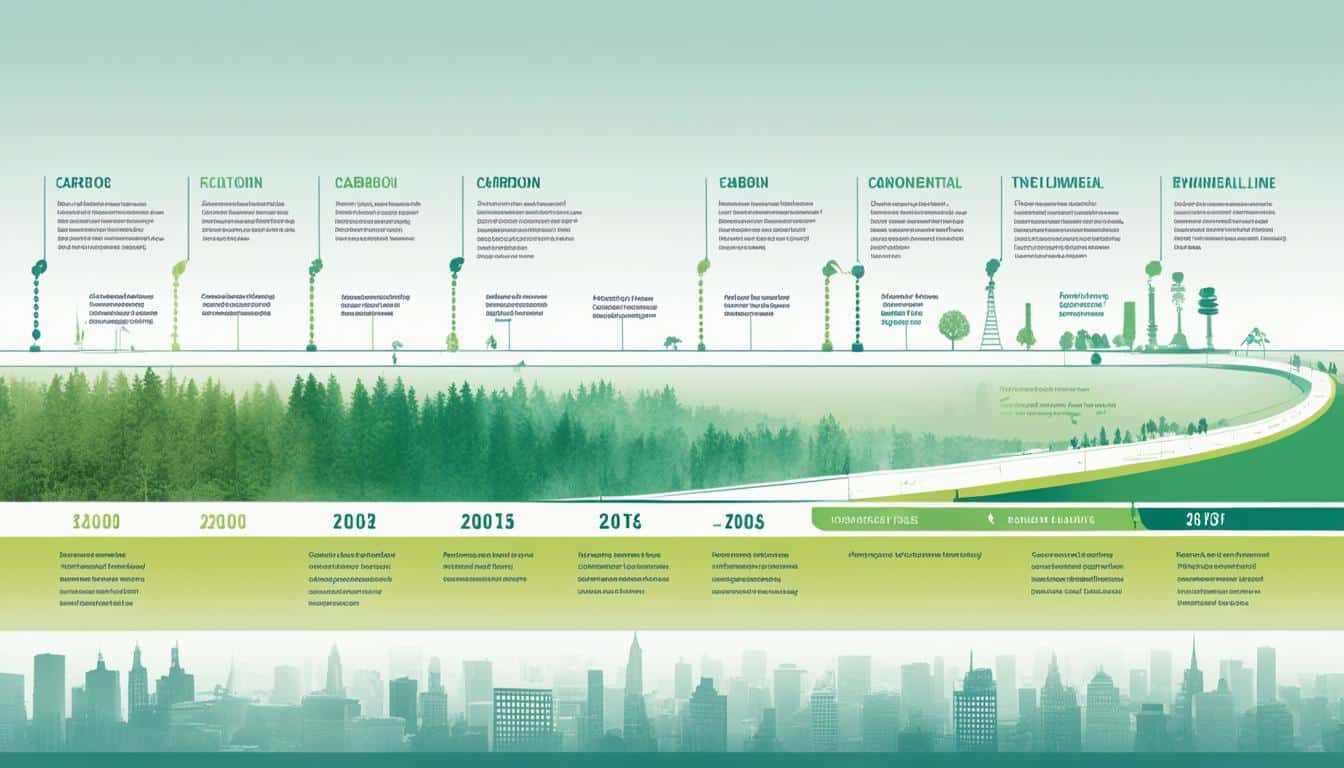
By 2024, a whopping 92% of big companies will ask their supply chains for ESG data. This marks a big change in how businesses see sustainability. The world’s environmental rules are changing fast because of climate issues and a big push for green policies. We’ve seen both improvements in clean tech and a counter movement.
New laws have made companies share more about being green. Moreover, the move to cleaner energy is a hot topic in places like COP28. This shift from using fossil fuels is crucial, especially since 2023 was a record-hot year. Elections, especially in the United States, will also steer green efforts.
Our forecasts on future eco-rules hinge on key global events. These include big talks on climate and the latest on sustainability laws. As the bar is raised, businesses and governments must get ahead to stay green. Being ready for tougher green rules isn’t just good strategy. It’s the way forward to a lasting green future.
The growth of environmental rules comes from many reasons, showing why we need to act. One major reason is to keep people healthy. By 2050, more people could die because of dirty air. This is a big worry for places like China and India. They will suffer more because of pollution.
The OECD thinks health problems will get worse from things like sulphur dioxide in the air. As countries get richer, they often improve their healthcare. But, there’s still a big need for strict environmental rules.
A big new plan, 534 pages long, shows how much we need to change. It follows the TCFD and Greenhouse Gas Protocol. It wants companies to share how they’re dealing with climate changes and risks.
“The proposed rule establishes a safe harbor for Scope 3 disclosures and requires attestation for large companies’ Scope 1 and 2 disclosures.”
But, some people don’t like this plan. They say it doesn’t have a good reason for being so strict. It might be very hard for companies and investors to follow.
New environmental laws will connect with changes in the world’s population, more cities, and better healthcare. It’s a big challenge as we get older and there are more of us. That’s why it’s vital to look ahead and be ready for new green rules and what they mean.
| Focus Area | Key Points |
|---|---|
| Human Health Concerns | Rising air pollution linked to higher mortality rates by 2050, particularly in emerging economies. |
| TCFD Framework | Proposal spans 534 pages, encompassing climate risks, impacts, and management processes. |
| OECD Forecasts | Increased emissions of sulphur dioxide and nitrogen oxides pose additional health risks. |
| Criticism | Proposal lacks clear rationale, materiality constraint, and cost estimates, complicating compliance. |
It’s key to know why and how environmental policies change and what they mean for our future. Making these rules stronger is important. It protects both our health and the planet against tough challenges.
Climate change is pushing for new laws to protect our planet. We see more extreme weather, like wildfires and floods, every year. This makes it crucial to come up with fast policy responses. These policies are key to dealing with the dangers from severe weather threats caused by global warming.
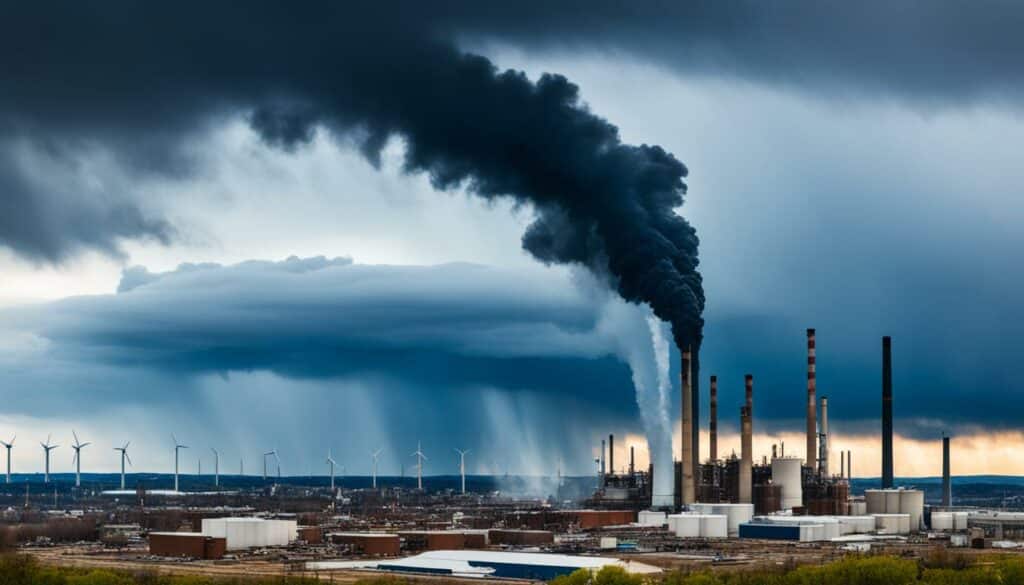
Extreme weather is making governments and companies act fast. They now work harder to avoid problems in the future. By planning better, they prepare for risks and improve their policies. This helps them meet goals like zero net emissions.
Global warming shapes the policies we need. It’s making governments and businesses change the way they operate and plan their supplies. Experts’ future predictions play a big role in this. They guide us on what we need to do now to be ready for the future.
Young people are also pushing for action on climate change. This is leading to more green strategy in companies and from policymakers. When businesses plan better for future problems, they get 14% more resilient. So, improving isn’t impossible.
Looking ahead, laws will keep changing because of these challenges. Organisations that get ahead of these changes can do well. They might even find new opportunities for growth and creativity in the strict new rules.
| Statistic | Details |
|---|---|
| Supply Chain Resilience | 70% of SMEs lack sufficient resilience |
| Organisational Resilience | 14% improvement through disruptive event prediction |
| Collaborative Innovation | 80% of SMEs engage in supplier-customer collaboration |
| Environmental Proactivity | Stakeholder orientation increases firm profitability |
| Green Innovation | Command-and-control regulation boosts performance |
The rules around protecting our planet are changing. Soon, we’ll see more focus on using renewable energy and cutting down on harmful gases. These changes are driven by both economic needs and smart planning for the future.
Experts say that laws about renewable energy are really going to matter. More and more, we’ll see the use of solar and wind power. Also, energy from water and the earth will become very important.
China’s rapid growth in solar power shows this change is happening. The International Energy Agency also agrees, saying renewable energy is the future. This means we can expect laws supporting it.
Focusing on cutting down on harmful gases is another key area. Nearly half of our gas emissions come from heating buildings. Using advanced heating systems can cut these emissions by a lot.
In 2024, it’s likely that better heating options will get cheaper. This will make switching to them more attractive. It can mean big savings for the planet.
Changes in how we move are also in the spotlight. Cars cause a lot of harmful gas. Choosing to cycle can cut the gas you make by two-thirds. This might lead to new rules about how we travel.
Lastly, we’re looking at using things over again. Businesses are starting to use more recycled materials. And, since so much food gets thrown out, there’s a push for composting. If done right, we can stop a lot of waste from going to landfills.
Elections have a huge impact on what happens with our environment. They are key times when future steps for the environment are decided. Also, they set the stage for how focused on the environment the government will be.
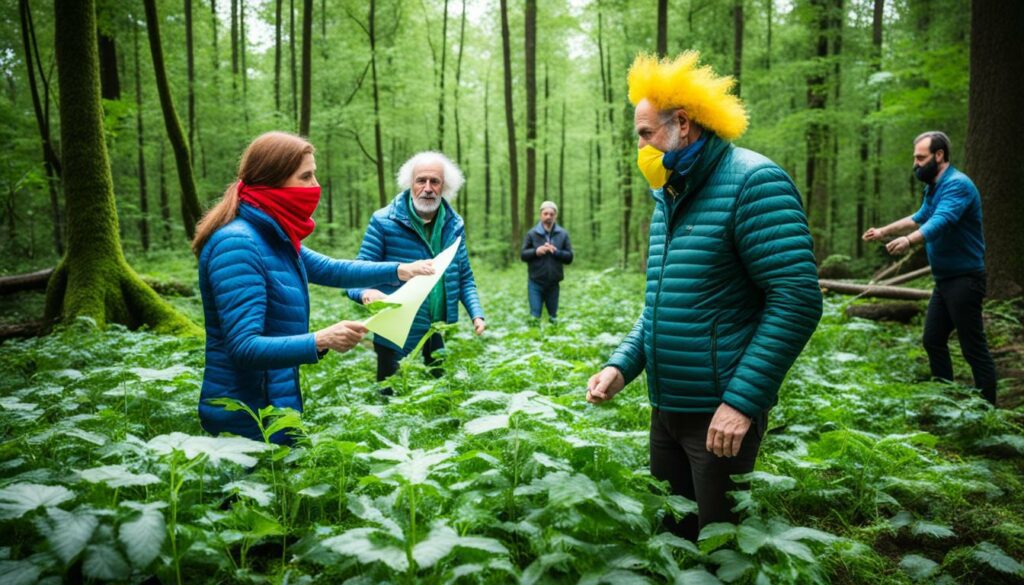
In the U.S., the presidential election is crucial for the world’s environment plans. When a new government comes in, it can make big changes in environmental rules. This can either help or slow down the work being done to protect the planet.
When the Biden administration went back into the Paris Agreement, it made a significant difference. It showed how elections can directly affect the fight for a better environment. Such changes affect how businesses think and act globally to protect the planet.
Worldwide, elections greatly influence policies on the environment. In 2024, countries like India and the U.K. have important decisions to make. These choices could better or weaken efforts to save the planet on a global level.
In the European Union, a focus on sustainability is growing because of election results. Directives like the Corporate Sustainability Reporting are a result of these elections. On a local scale, California is also making moves to protect the environment further. These can have a big effect even outside California.
The growth and cost-effectiveness of clean technology are big factors in the coming years. Political decisions will help decide how quickly these changes happen. As more people look to renewable energy, the political scene will be focused on making greener choices.
Looking ahead to future laws on sustainability means understanding environmental trends today. In 2024, there will be a big focus on measuring GHG emissions. Also, tracking a company’s climate impact will become more important. This is part of the bigger picture of future green laws, where business and government plans need to come together. This is to meet the growing challenges our world faces.
Around the globe, governments need to push for and make it easier to build smart grids. This step is vital to avoid big problems with our power systems and to keep our energy supply stable. Using Power over Ethernet (PoE) will be key for smart buildings next year. Buildings are a big source of CO2, so advanced technology is part of where laws are headed. This will improve how we use energy and reduce the harm buildings do to the planet.
Efforts like protecting forests and fixing coastal areas are more and more popular to fight climate change. These actions show a bigger move towards being more eco-friendly, which will be part of new green laws. This mix of protecting nature and having laws in place is an important step. It keeps in mind making our world better in the long run while dealing with issues now.
Artificial intelligence (AI) is also set to help in making our actions more sustainable. Although using AI needs more power and water, the results for the environment could be worth it. Advanced AI can help us use resources better, guess how we affect the planet, and run things more smoothly. So, AI is becoming a key part of how we plan to protect the environment in the future.
In summary, thinking ahead about sustainability laws means looking at both cutting down pollution and using new tech and nature fixes. This all-around approach shows how tricky it is to take care of the environment. The goal is to make a real difference for our planet in the long haul while fixing today’s problems.
The need for businesses to invest in corporate sustainability compliance is growing. They must consider environmental factors in their plans. New rules like the EU’s Corporate Sustainability Reporting Directive are pushing for this change.
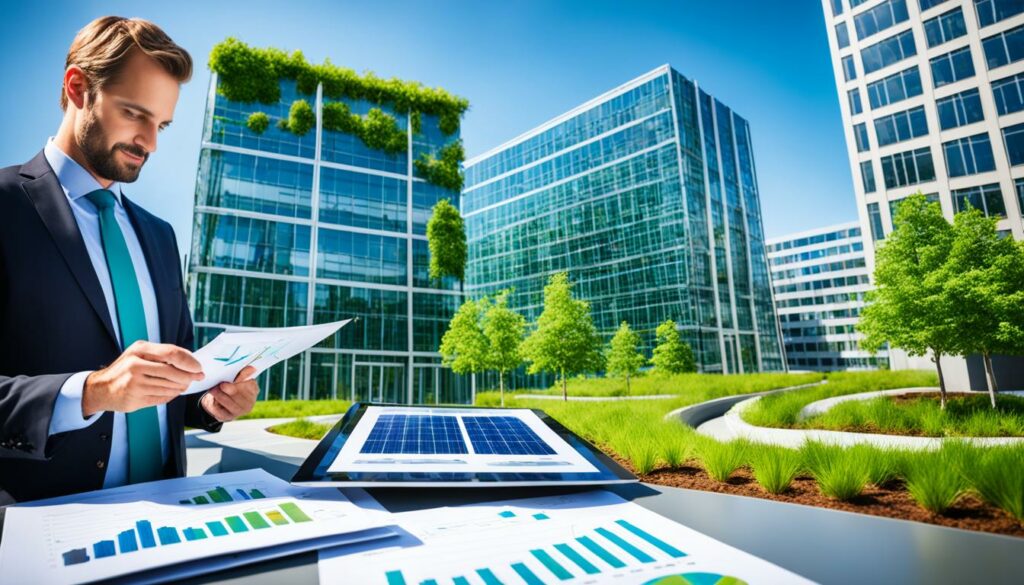
The Danish industry group thinks spending on non-financial reporting requirements will soon match what’s spent on financial reports. This change shows how much more corporations are expected to talk about their sustainability. The demand for open reporting is increasing, especially with new climate laws in California.
Being clear about environmental actions is crucial now. More ESG and sustainability laws were made worldwide in 2023. This shows a big push for corporate transparency requirements which help stakeholders decide.
Businesses are putting more effort into meeting these new standards. They are working together in industries like cement and steel to lower their carbon footprint. This response is a significant shift towards handling sustainability better.
| Key Metrics | 2022 | 2023 |
|---|---|---|
| Climate Litigation Cases (U.S.) | 1,522 cases | 1,636 cases |
| ESG Bills Introduced | Not Available | 240 bills |
| Investment in Sustainability Compliance | Baseline Level | Increased Exponentially |
| Global Renewable Capacity Added | Not Available | 440 gigawatts |
More and more, companies are spending on sustainability and being clearer about their green efforts. With these new steps, companies are meeting rules while aiming for a greener future.
New technology is changing how companies and authorities follow environmental laws. The recent rise in green tech plays a big part in changing the game. It helps industries and governments work better with environmental rules.
Machine learning (ML) and deep learning are key. For sites under the Clean Water Act, ML could spot more problems without extra checks. Deep learning can find 95 percent of pollution with only 10 percent of the effort doing it by hand. This tech makes checking for problems more accurate and quicker, easing the job for the checks.
In Colorado, the number of companies checking themselves jumped from 32 to 84 percent after a rule change. This shows how new tech can boost following the rules. It makes sticking to environmental laws easier.
From 2007 to 2017, government checks dropped by 45 percent, showing a need to predict when companies might not follow the rules. With tech, this is getting easier. Natural Language Processing (NLP) and Robotic Process Automation (RPA) tools help understand and use environmental rules better. They make keeping up with health and safety standards smoother.
In a study on EPA utilising ML algorithms, the detection improvement of water pollution violators soared by over 600% compared to random selection.
The benefits are hard to ignore. Looking at some key points, new technology has brought about big changes:
| Technological Method | Impact |
|---|---|
| Machine Learning | Doubling how many violations are found without more checks |
| Deep Learning | Using only 10% of manual work to find 95% of pollution sources |
| NLP and RPA | Make EHS management and following rules more efficient |
| Self-Certification | Making more companies follow the law, from 32% to 84% |
With support from the EPA, new tech is showing great promise in regulations. It points to a future where predicting rule breaks and using green tech lead the way in taking care of the environment.
The world is moving towards strict, eco-friendly rules for energy and waste. We see this in better building rules, rules for appliances, and cleaner ways for factories to work.

Expect standards for saving energy to get much tougher in homes, offices, and factories. For instance, Minnesota aims to use on-site solar power for 10% of its energy by 2030. Plus, cars in 2022 set a new high with 26 miles per gallon on average. This is the best improvement in ten years.
There’s a big focus on laws for dealing with all the waste we produce. In America, about 40% of food is wasted, causing big problems like methane in dumps. Each year, this waste equals $500 per person. The fashion world also plays a role, with a carbon footprint larger than flights and shipping. This boosts the efforts on making new from old and producing less waste.
In today’s world, focusing on sustainability is crucial. We find that working together toward green goals really makes a difference. When cities and companies team up, they can do more for the planet.
Many cities worldwide are sharing data to help with their GHG inventories and climate plans. This shows how powerful teamwork is in taking on environmental challenges. In Dublin, Ireland, they used an electric Street View car to measure air quality. This information helped make life better for people living there.
In Hamburg, Germany, a technique called the Project Green Light made a big impact. It helped cars stop less and reduced emissions by 10% in certain areas. Such success stories prove how working together can cut our carbon footprint.
Recently, a Google survey found that 82% of people think about sustainability more now. Also, 78% believe big companies should help fight climate change. This shows that we all care more and want to see action.
Google’s Flood Forecasting Initiative warns us about floods, helping to protect lives and property. Wildlife Insights platform helps keep track of animal photos online. These technologies are key in saving our planet.
A fund has given $30 million to speed up climate projects. Also, nearly $9 million supports areas hit hard by climate change. These actions prove what we can do when we come together.
| Initiative | Impact |
|---|---|
| City Data Sharing | Enhanced GHG inventories and climate action |
| Electric Street View Cars in Dublin | Improved air quality measurements |
| Project Green Light in Hamburg | 25% fewer stops, 10% emission reduction |
| Google Flood Forecasting Initiative | Predicting and mitigating riverine flooding |
| Wildlife Insights Platform | Supporting conservation efforts |
| Impact Challenge on Climate Innovation | $30 million allocated for climate projects |
| Environmental Justice Data Fund | Nearly $9 million in grants for climate justice |
These stories show how working together can lead to real change. By coming together, we can make our planet better for all.
The latest developments in clean technology are making big changes in global environmental rules. We expect a 50% rise in green energy capacity from 2019 to 2024. Solar power is at the front, pushing for new laws to cope with more renewable energy in the system.
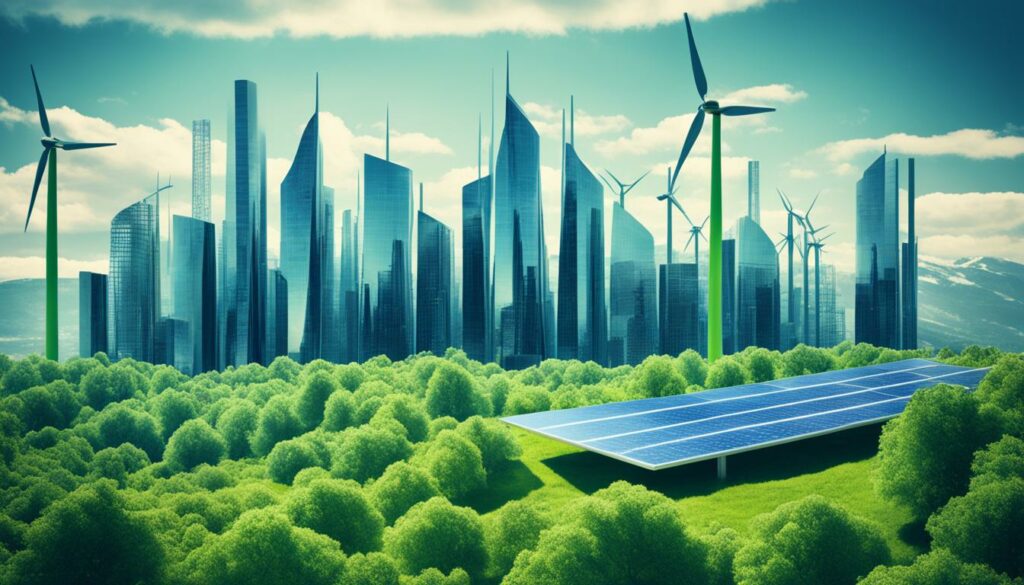
Solar energy is set to grow by 600 GW worldwide by 2024. This is nearly as much as all of Japan’s electricity production. The U.S. aims to double its solar setups to four million by 2023.
This growth could greatly change how we handle rules around renewable energy. By 2024, home solar will likely hit 142 GW, thanks to China’s wide use. Businesses and factories will also turn more to solar, potentially reaching 377 GW. This pushes the need for solid green energy regulations.
The rise of electric cars and smart grids is key in creating new laws. In the U.S., electric car sales are expected to jump from 978,000 in 2022 to 9.4 million by 2030. This means we need clear rules for the new charging and power systems.
Big car makers like Toyota and Ford are helping the U.S. electric car industry grow. Their manufacturing is set to go up from 641,600 cars in 2022 to more than 4.6 million by 2026. Additionally, smart grids are vital for efficient energy use. They’re also changing how we look at energy laws, leading to new rules to make them easier to use.
This progress asks for a review of old policies. We need new, smart rules to back the quick move to cleaner energy ways.
Decarbonisation strategies face tough challenges across technology, economy, and society. The cost of switching to cleaner energy sources is a key issue. It’s hard for many, particularly in poorer areas, to afford the change. Also, false information makes it hard to understand the real impact of emissions.
Reducing our carbon footprint meets hurdles with current regulations. These rules slow down how quickly we can make important changes. The way we study the effects of going green on EU goals points out these roadblocks. It’s not easy to line up all the different policies and actions needed.
Overcoming these tests needs strong rules that push for less pollution. Money incentives for cleaner choices help a lot. With these, we can better plan for the future and make sure everyone benefits.
Changing how we act on a big scale helps cut down emissions. This includes using cleaner transport and energy. Going for zero emissions can make us all healthier and our farms more productive. However, we must also cut down on local pollution and push for greener habits. This is the best way to fight climate change fully.
Places with less progress in meeting development goals gain the most from eco-friendly actions. But, these actions can also hit the economy and living standards hard. We need careful plans to handle these challenges.
A recent study on reaching climate neutrality in the EU outlines why we need smarter policies. By dividing tasks fairly, as in the ‘Fit for 55’ model, we can pull through tough regulations. This way, we get closer to our clean-energy goals.
The future of our planet’s laws will be shaped by global efforts to tackle climate change head-on. The Paris Climate Accord and similar agreements mark big steps towards fighting climate change together. But different parts of the world have their own unique environmental issues, leading to varied green laws.
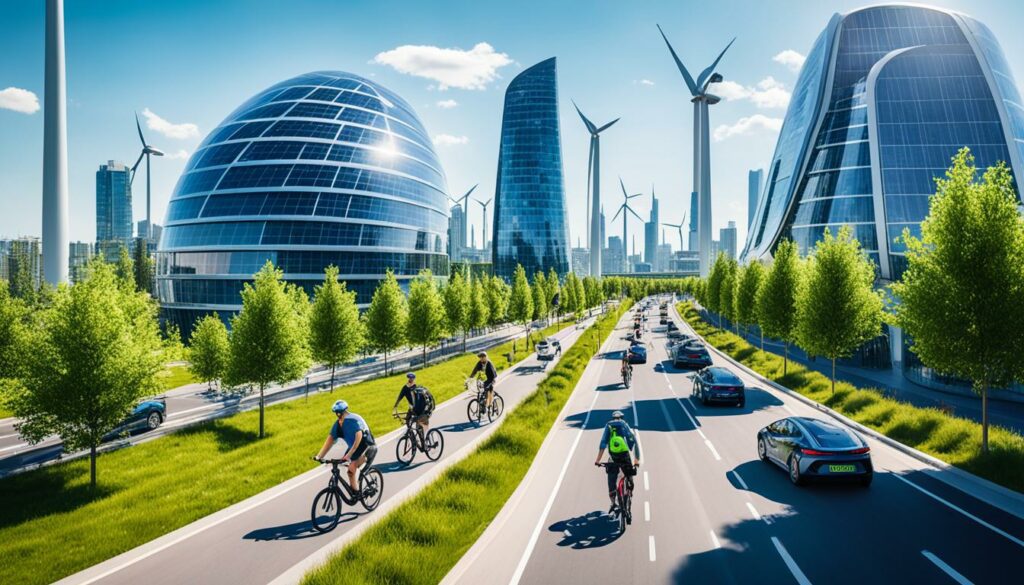
Big international promises are at the heart of future environmental laws. The Paris Climate Accord, for example, sets high goals to cut down on earth-warming emissions. Without strong actions, these emissions could rise sharply, causing serious harm to our planet.
We need to cut global emissions by 39% by 2050 to keep our planet liveable. To do this, the world must invest in new green technologies and policy changes. This will require a big investment, nearly $340 billion every year by 2030.
Although the world is working towards common climate goals, every region has its unique challenges. Europe, for instance, aims to increase its use of solar and wind energy in the face of rising costs.
Areas struggling with water shortage will focus on better management of this vital resource. Places threatened by loss of natural habitats will put policies in place to protect wildlife. Each region’s primary concern guides its environmental laws.
Here is a snapshot of what different regions are focusing on:
| Region | Primary Environmental Focus | Key Policies |
|---|---|---|
| Europe | Renewable Energy | Solar and Wind Energy Promotion |
| Asia | Water Management | Sustainable Agricultural Practices |
| North America | Emission Reduction | Electric Vehicle Incentives |
| Latin America | Biodiversity Conservation | Habitat Protection Laws |
To make future green laws work, we must keep both global and local needs in mind. This way, we can effectively combat climate change and protect our environment together.
Environmental regulations have evolved over time. They were shaped by key events and the development of policies. It’s important to look at our past and plan for a future that overcomes new environmental problems.
Major events have marked the history of environmental regulations. Acts like the Clean Air Act and the Clean Water Act started a green movement. They helped tackle big problems like pollution. These acts guide the rules we have now and will have in the future.
We need to keep learning from our past and adapt. Without new policies, our air could get much dirtier and our planet hotter by 2030. To avoid this, we must cut global emissions by almost 40% by 2050.
Many milestones have changed the way we make environmental laws. The OECD showed us how to fight big problems without hurting the economy too much. Also, the Clean Water Act has made a big difference in reducing water pollution in 25 years.
By putting a limit on air pollution, we found the benefits far outweigh the costs. These moves prove that our regulations can make a real difference. We must keep updating our rules to face new challenges, like water shortages and climate change.
To balance sustainable economic development with environmental responsibility in growth strategies, leaders must find new ways. If we don’t act, greenhouse gases could rise a lot by 2030 and 2050. This could lead to temperatures climbing by 1.7-2.4° Celsius by 2050. It shows why we need to mix green ideas with how we grow our economies.
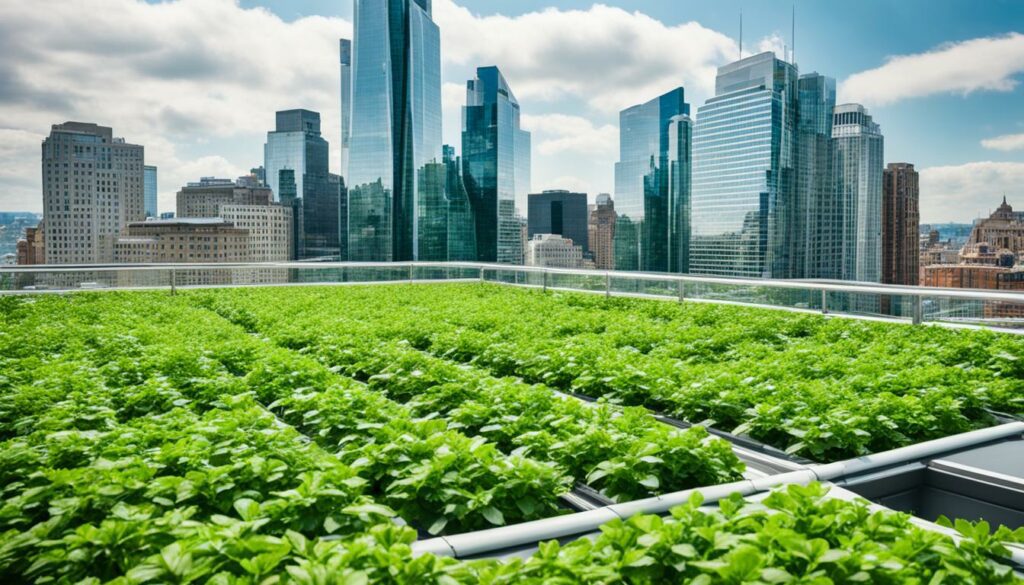
Looking towards green energy and new technologies is a good step. We need to cut emissions by 39% before 2050 to keep CO2 in check. The United Nations and the IPCC believe smart policies can help the planet and still let economies grow.
Global teamwork is important too. Working with the “BRIICS” (Brazil, Russia, India, Indonesia, China, South Africa) makes reaching green targets cheaper. Together, we can boost jobs in eco-friendly ways and keep growing without harming the earth.
So, here are some important facts about sustainable economic development:
| Parameter | Value |
|---|---|
| Projected GHG Emission Increase by 2030 | 37% |
| Projected GHG Emission Increase by 2050 | 52% |
| Anticipated Global Temperature Rise by 2050 | 1.7-2.4° Celsius |
| Estimated Cost of Environmental Policy Package | Just over 1% of World GDP by 2030 |
Putting money into green energy and eco-friendly jobs is a big step. It not only helps our planet but shows that green plans can work. Spending a bit more than 1% of the world’s money by 2030 on the right plan could really help. It’s good news for the economy and our environment.
Non-Governmental Organisations (NGOs) are now pivotal in changing environmental laws. They have moved power away from just the government to include other groups. This change is leading us into a new era where groups that are not part of the government hold a lot of power too. NGOs bring special knowledge, point out issues others ignore, and make the process of setting policy more open.
Environmental groups work hard to shape eco-friendly policies. They talk to politicians to push for green laws, making democracy work better. These groups have made a big impact outside of what governments can do because they are seen as honest and knowledgeable. For example, they helped create global deals like the Rio Declaration, the Montreal Protocol, and the Kyoto Protocol.
These examples show how environmental groups have used their influence to fight against just what states want. They helped with important environmental agreements and helped solve problems.
NGOs also have a big effect on how companies act with their social and environmental responsibilities. By checking on businesses, these groups make sure they follow strong rules for the environment. NGOs get people to agree on important values or ideas and support from members, money, and strong knowledge. This helps work with both the public and private sectors to protect the environment better.
NGO influence on environmental legislation and their advocacy show a clear move of power from just the government to other groups. The work of these organisations is crucial in making policies that fight global environmental problems.
Environmental regulations keep changing, so businesses must stay ahead. They need strong plans for making their operations greener and reducing risks. This ensures they follow the rules.
Businesses should make being green a big part of all they do. This means thinking about the environment in everything, from where they get supplies to making new products. A key point here is that in 2023, China added more solar power than the U.S. currently has. This shows how crucial investing in renewable energy is.
As 2023 was the hottest year, being greener has become even more urgent. New rules are pushing companies to be more open about what they’re doing to help the planet. They will now need to report their environmental activities, just like they report their finances. About 50,000 firms are expected to start doing this in 2024, showing a big change is coming.
Being ready for new environmental laws is crucial. It’s not just about following the rules but foreseeing what’s coming. For example, California is making companies do more on sustainability reporting. To be ready, firms must regularly check for environmental risks and act quickly to solve them.
The growth in renewable energy, with 440 gigawatts more in 2023, means businesses have to keep up. This could help reduce risks from inflation and supply chain problems. Also, companies are working together more, especially in heavy polluting areas like making cement and steel. This shows everyone is trying to do their part for the planet.
In the end, getting ready for environmental rules means doing more to be sustainable and manage risks. By investing in these areas, companies can follow the rules, build a good name, and lead in caring for the environment.
Looking ahead, the future of our environment depends on new technology, smart money decisions, and the will to make things happen. The year 2023 showed us why we must act now. It’s time for smart moves and working together to make strong, flexible rules.
Experts see big things coming for green energy in 2024. They say we need to find better ways to heat our buildings without polluting. Soon, eco-friendly ways might cost the same as harmful ones. That’s a big boost for green building practices.
Recycling and green transport will play a huge part in shaping our planet’s future laws. More plastic packages are being made from recycled stuff. And cutting down on thrown-away food will be a big deal. Biking more and similar moves will help tackle pollution, fitting well with upcoming green rules for 2024.
But, not many big companies are really aiming for net-zero. This shows we must watch them closely and make sure they’re not just talking. Groups like TNFD and EU’s CSR Directive are pushing for clearer reports on nature impacts. They also want companies to follow strict green rules.
It’s a tough road. But if we stay strong, work together, and keep our goal in sight, we can make it. Taking on these eco challenges can push us all to do better and lead to a cleaner, healthier planet. Today’s efforts will lead to a brighter future for us all.
The main focuses are now on fighting climate change. This includes using more renewable energy and cutting down on greenhouse gases. Also, companies have to report more on their environmental efforts.
Wildfires, floods, and storms push us towards stricter policies. These policies aim to lessen risks and tackle climate change challenges.
Election outcomes can change the path of environmental policies. New leaders may push for stronger green rules or slow them down.
More money is going into sustainability efforts and reporting. The EU, for example, wants companies to share more about their green practices.
New tech like renewable energy and electric cars is key. These innovations help meet the demands of green regulations and cut the use of fossil fuels.
We expect new rules for better energy use in buildings, machines, and factories. These rules want to cut down on energy waste and help the planet.
Working together, people from different areas can make big changes. They share their resources and knowledge to come up with strong ways to protect the environment.
More green energy and technologies like electric cars mean we need new rules. These regulations will help new sustainable energy models grow.
Switching from old energy ways to new ones is not easy. Challenges include the cost, wrong information, and needing clear rules and rewards for less polluting activities.
Countries have agreed to fight climate change together. But each place has its unique plans. They all aim to meet worldwide goals in their own way.
Important laws like the Clean Air Acts show our move to being proactive. They help make new laws that are smart and ready for changes.
Future rules should help the economy grow but not hurt the planet. They should encourage new green businesses, green jobs, and use more renewable energy.
NGOs raise awareness and push for changes. They have a big role in shaping the rules for companies and collaborations that care for the planet.
Companies need to focus on being more green. They should fit their models for the earth, share their green work, handle legal risks well, and learn always to follow the rules.